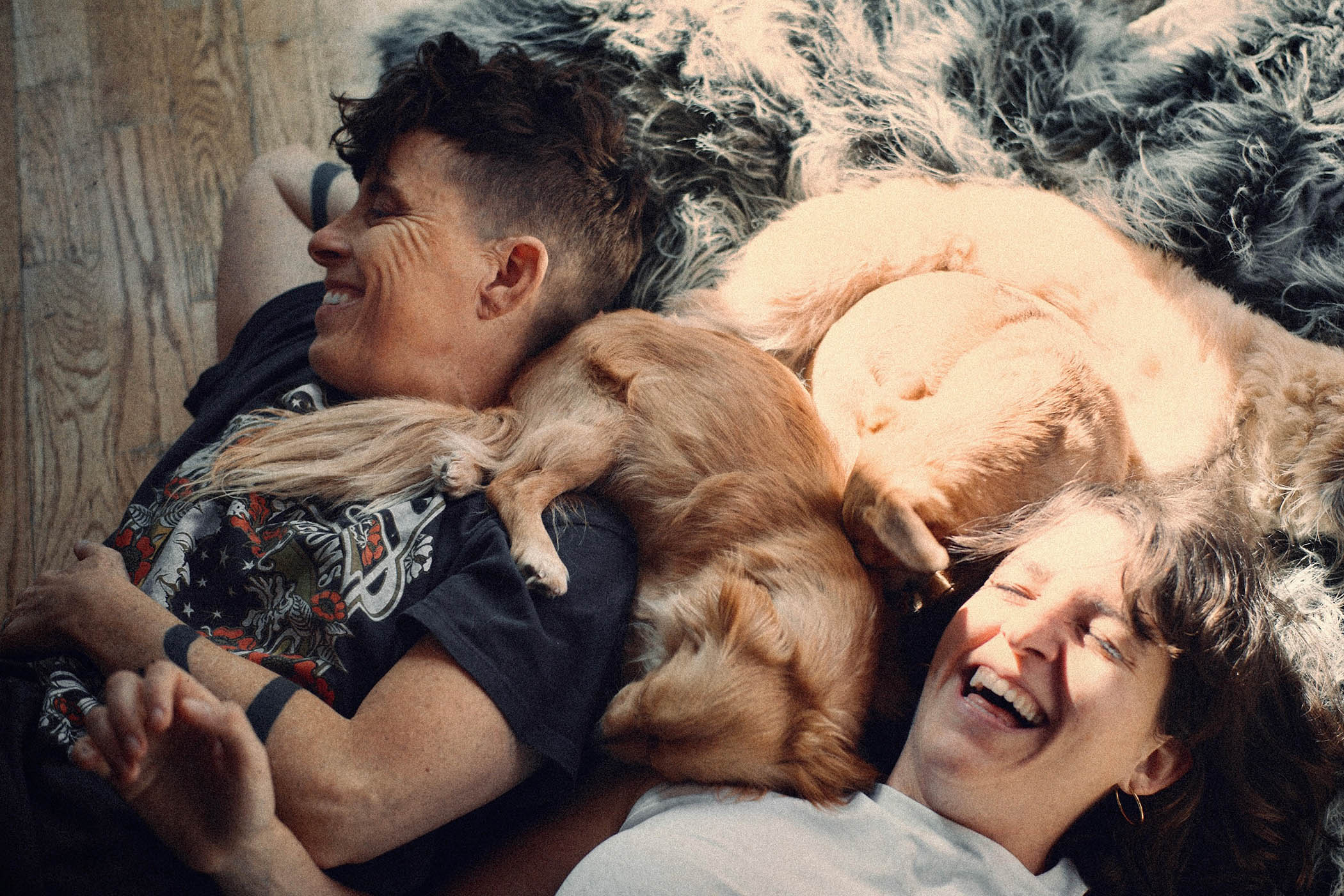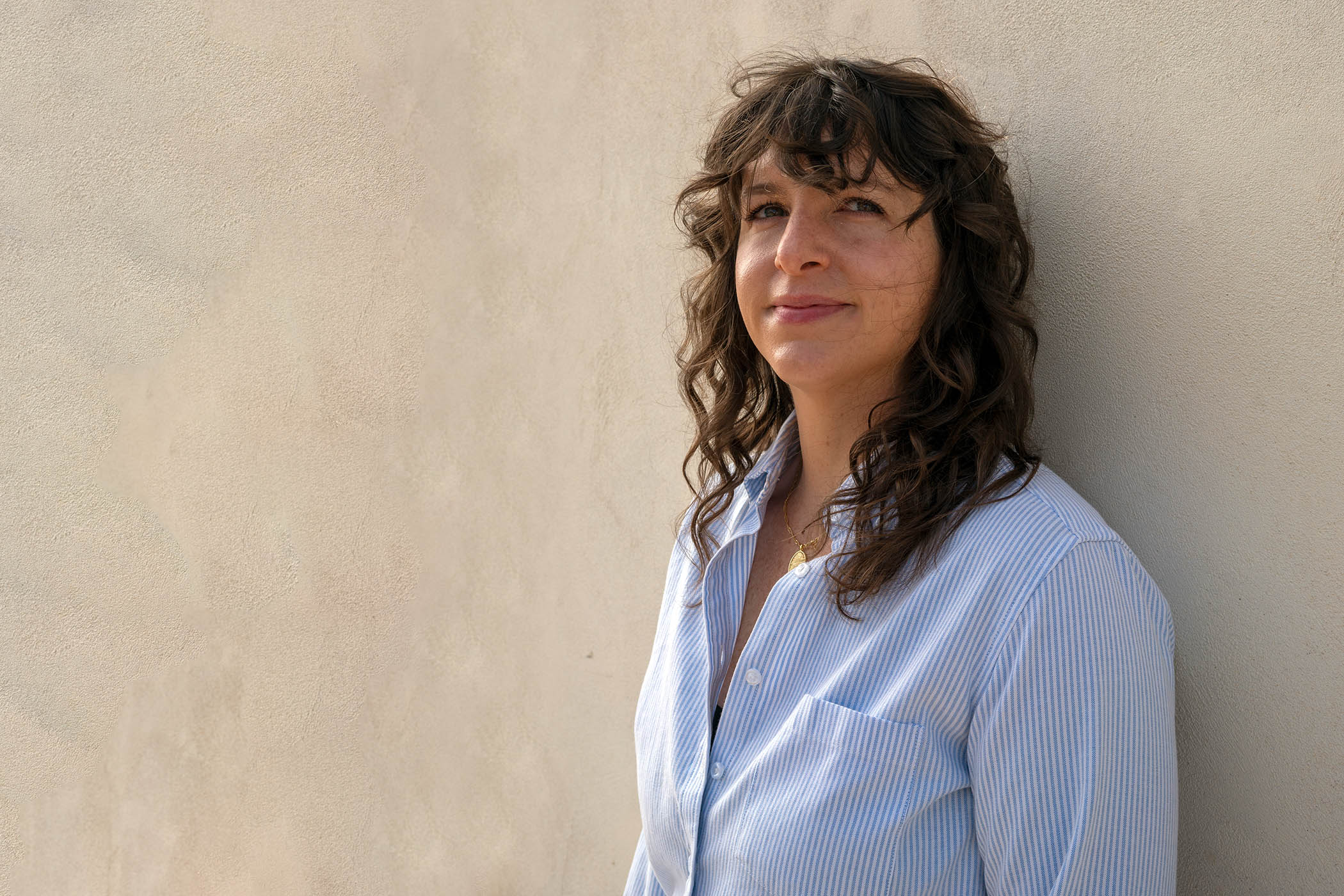Portrait by Joe Leavenworth
Three years into the poet Andrea Gibson’s treatment for ovarian cancer, Gibson and their wife, Megan Falley, were so committed to living in the face of death that the couple made no sense to the people around them. “We had tried as writers, and in some ways failed, to communicate with our close friends and family what a beautiful time we were having: that we were dancing through Andrea’s diagnosis, that we were singing more and laughing more, and more in love and happier than we had ever been in the six years prior in our relationship,” Falley tells me. “It was almost like our friends didn’t believe us.”
It was during this time that a close friend of the couple approached them with the idea of making a documentary about their experience, introducing them to the award-winning film-maker Ryan White, whose previous subjects included Pamela Anderson and the then 90-year-old Holocaust survivor turned celebrated sex therapist Dr Ruth Westheimer.
In 2023, White made the journey to rural Colorado with his producing partner Jessica Hargrave to meet the couple. Falley recalls that after the pair pulled into the driveway, Gibson greeted them by saying: “I guess you’re going to be here with me when I die. Welcome to my home.”
That mixture of dark humour and quick intimacy is the lifeblood of the documentary, Come See Me in the Good Light, which airs this week on Apple TV+ after its premiere in January at the Sundance film festival, where it won the festival favourite award as voted for by the audience.
Related articles:
When I spoke to Falley in October, she was back at the home she shared with Gibson – who used they/them pronouns – in Colorado after spending some time at a women’s writing retreat. “It’s cosy to be home and among Andrea’s things,” Falley says from their living room. On one wall is a neon light shaped into the words “Stay tender”, which in the documentary feels like a flashing reminder.
The couple’s determination to stay tender – and to really live despite death looming – never wavers, even as we watch Gibson open their blood test results every three weeks and a number is put against the level of cancer in their body. As Gibson puts it in the wake of the diagnosis: “You don’t want to waste a second – and I was wasting a lot of seconds [before].”

Megan Falley, right, says that being able to watch footage of her late wife Andrea Gibson is ‘a privilege’
Falley says that their shared determination to hold on to gratitude and joy was partly her own innate way of seeing the world, but also an act of care. “It would have been a terrible disservice I think, as a partner, to bring Andrea down in any way from that place that they were in.”
In a poem of Gibson’s reflecting on their illness called Tincture, they write of how “the body prays / how it burns and begs for another average day”. The documentary, which catalogues both extraordinary and very ordinary moments, is a record of so many of these supposedly average days. White only used a fraction of thousands of hours of footage over the course of a year; the unseen hours are a stockpile that gives Falley great comfort. “I know that I will see things that I don’t remember happening, which is such a privilege. Everybody loses people – not everybody gets to have thousands of hours of their love documented.”
The couple’s sense of humour is evident from early on in the documentary, when they sit around the kitchen table joking with a friend about Falley “fingering the cancer out of Gibson”, then collapsing in laughter over a joke about “thumbing”. This conversation happened on the first night the cameras were set up and caused White to describe them as “unicorn” subjects, explaining that it usually takes documentary subjects months to warm up like that.
Their sense of ease may be explained by the comfort the couple found in each other. For many years, Falley and Gibson lived in shame and pain about their bodies and their sexuality. The couple met through the poetry scene and got together as Gibson was drawing large audiences at their spoken-word events. Gibson often used startlingly plain language to describe suicidal moments in their past, drawing in fans beyond the immediate poetry community and helping people in the audience work through their own struggles in the process. Take this example from her poem Living Proof:
The last, and I mean the last time,
I tried to return myself to sender
was a year ago this June.
After five months so sick I was certain
my stomach would never know a butterfly again,
I got so low I had to look up
to see rock bottom, and, ghosted by hope,
I got in my car and started driving toward
a dead end, a cliff that had been my backup plan
if ever the pain got stronger than I am.
At the time, Falley was working on a memoir about her issues with body image while also writing poetry. At one point in the documentary, she teases Gibson about only using the same five words in all their poetry. Deadpan, Gibson replies: “Do you know how good you have to be to write poems with only five words?”
Come See Me in the Good Light does not end with Gibson’s death. Instead, they lived long past their initial two-year prognosis and were able to see the documentary with an audience. In July, they died at the age of 49, surrounded by friends, family, ex-partners and dogs at home. Falley says she felt so attuned to Gibson’s needs that she knew exactly how to shuffle people through the house in order to curate the perfect environment for them.
But when the time came and the hospice nurses sedated Gibson, Falley hadn’t been aware that they would very quickly lose the ability to communicate. “That was really hard for me because I wanted a final conversation to ask: ‘How will you visit me?’” she says. “Within hours of feeling that, I got a love song recorded by our friend with lyrics that Andrea wrote about where to find them when they die. They didn’t have words left but I had this beautiful song.”
Since Gibson died, Falley has adjusted to watching the documentary alone. “The first time I saw it without Andrea, earthside, let’s call it, I was just weeping the whole way through,” she says. “I wanted to reach through the screen and pluck them out of it. I had my rational mind that knew that wasn’t possible but there was also this body response where I felt like I could just reach out and they’d be here.”
The experience reminded her of watching the film Titanic when she was nine years old, remembering how she cried so hysterically that a woman suggested her mother take her outside. As a child, she refused to leave; she does now too. “I will always stay in the theatre,” she says. “It’s not going to be too much for me to see Andrea. Of course I want to see them and their face 15ft high in front of me. What a privilege that is. And then to be in a dark room where 100 other people are falling in love with Andrea at the same time.”
I wanted to reach through the screen and pluck them out of it. I felt like I could just reach out and they’d be here
But after the film ends, Falley says, is when the real alchemy happens as the politeness of small talk falls away. “Immediately, folks tell me about people they lost and they get to have a similar moment where somebody they maybe haven’t spoken about in some time gets to be born again into somebody’s consciousness,” she says. “It goes deep fast and I want life to go deep fast.”
After a recent screening in New York, Falley was approached by the writer Elizabeth Gilbert, whose memoir All the Way to the River recounts a similar experience of losing her partner to cancer and the bursts of joy, creativity and deep spirituality that showed up along the way as she held someone until their final breath. “Liz said something really beautiful to me, which was: ‘I am so happy for you both.’ I felt like she got something that, without experiencing a similar grief, would be hard to access.”
Falley has also been carrying on the Substack blog Gibson began as a project titled Things That Don’t Suck before their diagnosis and continued after it. Now, “as a 37-year-old widow”, Falley feels the universe still challenging her to find things that don’t suck.
Lately, Gibson has been showing up for Falley in their own mischievous ways, reminiscent of a line from a poem they wrote shortly before their death titled Love Letter from the Afterlife, in which they say: “I am more here than I ever was before.” Falley recently heard her Alexa device turn on unprompted in another room and start playing some of the songs that were theirs – old soul tracks such as Stand by Me and Lean on Me. “Then, all of a sudden, it starts playing Eminem. ‘Guess who’s back? Guess who’s back? Guess who’s back? Guess who’s back?’ Then it switches to the Bee Gees’ Stayin’ Alive,” she says. “It felt like being flirted with. I was laughing the whole day, like the giddy way you feel when you’re falling in love with somebody.”
Sometimes she sees Gibson in the natural world, too. A flash of them within a lightning storm or beamed through a beaming sunset. “I’ve wondered: is this how the first gods were invented?” she says. “Incredible people who we didn’t want to lose, so we attributed the sky to them.”
Come See Me in the Good Light is on Apple TV+ from Friday 14 November



